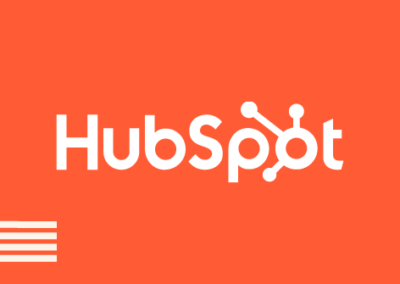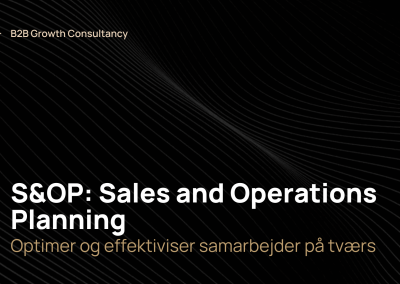B2B means business to business. B2B covers trade between businesses, while B2C focuses on trade between businesses and consumers. Within B2B there are different disciplines such as B2B sales, B2B marketing and B2B segmentation.
B2B sales
B2B sales, or business-to-business sales, refer to transactions between businesses rather than between a business and an individual consumer. This type of sale is often characterized by a longer sales cycle and higher transaction values, and it typically involves more decision-makers.
The sales process is most often conducted through a CRM system, which is implemented to streamline a company’s sales activities through data collected by marketing and other departments. This allows the company to create a more tailored experience for the customer.
The above is incredibly important when defining your B2B sales strategy. The ICP– ideal customer profile – is typically also within the segmentation criteria of other companies. This means that the customer will typically receive inquiries from several different companies. To stand out from the crowd, it is therefore important to have a tailored, relevant and unique approach to the sales process.
Read here about 4 benefits of using HubSpot in B2B.
Explanation of the B2B sales process
B2B segmentation
The purpose of a B2B segmentation is to identify and understand the companies that will benefit most from your product or service. You need to define your B2B segmentation criteria, which can be anything from net revenue, tech stack, employee staff, etc.
In recent times, we have intelligent tools such as LassoX that help to make razor-sharp B2B segmentation criteria and define your ICP based on accounting class, key figures, number of employees, industry codes, etc. It is therefore incredibly important for a company to define its ICP as precisely as possible, as these tools can help to make larger extractions of relevant companies.
See how Radiant can help you define your ICP through HubSpot as a Service.
B2B sales and negotiation techniques
B2B sales often involve complex negotiations. It’s important to have competent salespeople who understand the customer’s needs, can present the value of the product effectively and can handle objections from leads – potential customers who fall within the company’s segmentation criteria.
Most markets today are filled with salespeople. In the battle for leads, it is therefore essential to have the best executed sales and negotiation techniques to win the customer and close the sale.
Here you can read more about how Radiant performs Sales as a Service for businesses.
Download our 5-Step Pitch Model here
Building B2B partners
In the B2B world, it’s not just the sale that counts, but also the relationship. Building strong, long-term business relationships can lead to repeat sales, referrals and a strong position in the market – so partnering is a clear B2B sales strategy.
Take, for example, a company that works in sales. Here, it is beneficial for the company to partner with companies that specialize in dashboards, segmentations, CRM systems and marketing agencies, as they all have the same customer base but complement each other.
Read this article for more information upon “B2B lead generation“
B2B Marketing
While B2C marketing often focuses on emotional triggers, B2B marketing is more oriented towards value, ROI and solutions to business challenges. Below we review two popular B2B marketing strategies.
B2B marketing strategies
Demand generation
Demand generation is about creating demand, addressing issues and showing opportunities. This discipline is all about reaching as many relevant users as possible. The reason why relevant is in italics is because demand generation is also about educating the many potential customers who are not yet in the market and can be difficult to define.
In demand generation, content marketing as a B2B marketing strategy is incredibly popular as it’s quick to get started.
Content marketing
Content marketing is a strategic marketing approach focused on creating, publishing and distributing valuable, relevant and continuous content to attract relevant customers. At its simplest, content marketing is about being visible to your target audience through good content. Here are three tips for content marketing:
1. Create valuable content
Instead of pitching your business and services and talking about why you’re the best, make your advice etc. available to your potential customers. This way, you can build thought leadership in the field – that is, you provide your ICP with valuable content that demonstrates your professional expertise through knowledge, insight and dialogue.
If your ICP encounters a problem or question in the future, you will be top-of-mind and they will hopefully reach out to you to solve their needs. Content marketing and incorporating value into your content should therefore also be seen as branding in being the professional and professional player in the market.
2. Focus on your target audience
Create content that answers relevant issues facing your target audience. In its simplicity, this is very obvious and something most companies do. But by taking the extra two minutes to understand your audience’s needs, you can target specific issues and differentiate yourself from all the content out there – and that’s essential to be competitive in your industry.
3. Reuse content
Reuse your content in multiple places. For example, you can share a post on both LinkedIn and Facebook. You can also share your most engaging organic content as paid advertising, or you can compile your top ten tips in a powerpoint to share.
Being good at repurposing your content is a great way to grow your exposure without using too many resources. The biggest work is in creating content – not in distributing it.
Demand capture/demand generation
Imagine you’ve created a lot of content that has educated customers who – through content marketing and demand generation – are now ready to buy. Now you need to make sure these customers come to you rather than your competitors.
Getting these customers to reach out to you is most often done through paid advertising on LinkedIn and Facebook, search engine optimization and Google Ads, where search intent (i.e. the intent behind a user’s Google search) shows when a user is ready to buy.
This strategy is the one that drives growth, but it’s born of demand generation. The two must be seen in tandem – therefore it’s important to not only focus on demand capture but also on demand generation in your B2B marketing strategy.
B2B Segmentation
Segmentation in B2B is extremely important. Segmentation ensures that your inquiries to your ICP are relevant and don’t appear as spam. This makes it more likely that you will receive a positive response.
How to create a B2B segmentation
When segmenting your B2B customers, it’s important to have an overall understanding of who your target audience is. Where it really comes in handy is when you can segment based on something specific, such as accounting class, growth in key figures, titles or what tech stack they use. The important thing is that your solution can solve a problem in terms of these specific segmentation options, as this is how you can make yourself relevant.
An example would be if you’re helping companies that have experienced high revenue growth to hire employees, as this can quickly take up valuable time from non-HR specialists. Here, you can use various tools to extract data on companies with growth in headcount, revenue, etc. to indicate who has this particular issue.
Benefits of B2B Segmentation
Increased efficiency
By focusing on specific segments, companies can tailor their messages in ads on their website and offers. This way, your company can demonstrate its relevance through its knowledge of what problems to address with your target audience – and this can lead to higher conversion rates and ROI on your work.
Better customer understanding
Segmentation gives businesses a deeper understanding of their customers’ needs, challenges and buying behaviour. This can inform product development, pricing and other strategic decisions. Either way, in most cases, thinking about who your ideal customer is will add value, so you can be razor-sharp in your messaging and avoid targeting irrelevant companies.
Stronger positioning
By addressing the unique needs of your segments, your business can more easily position itself as an expert or leader in an area that will attract more customers. This ensures that you are razor-sharp in your message and, as pointed out above, in ads, on your website and in your content universe. Your strong positioning can ensure that you will automatically attract customers based on where they are in the buying process.



